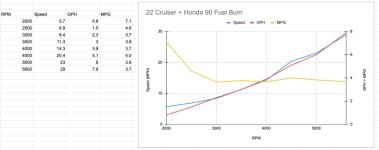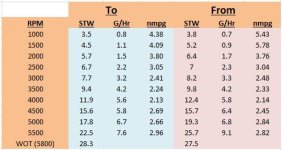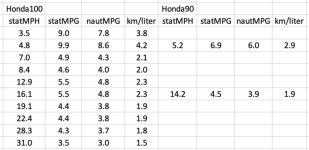Ahoy! New 22 cruiser owner here. Curious about where the boat operates most efficiently, one of the first mods I did was to add a GFS10 fuel flow sensor to the Garmin MFD that came with the boat. My girlfriend and I did about 50 miles today and I was able to run an experiment where I collected fuel flow data at various RPMs/Speed. Each data point was collected with the motor and tabs trimmed for highest speed at that RPM. I first trimmed motor with permatrim plate for highest speed, then played with trim tabs. I found that the boat actually went a little faster with about 1/2 bow down trim on tabs. They seemed to "lift" the stern some and help the boat ride flat on the flat section of the hull.
I entered this data into a spreadsheet, calculated MPG, and then plotted Speed, Burn Rate and MPG vs. RPM hoping to find a speed with the best efficiency. Obviously, slower should be better but I was curious to see if there was a dip in efficiency at semi-planing speeds (where you throw the biggest wake). Surprisingly, fuel economy seemed pretty consistent at around 4 MPGs from about 8mph all the way up to full throttle around 30mph.
I hope some of you find this interesting or helpful. Has anyone else measured similar results?
Now if I could only be smart enough to figure out how to access and upload photos to my album on here... Here's a link to the FB post I made on the Cdory owners group with a picture of the plot and data...
https://www.facebook.com/share/p/ugFAGu4fb8TV1y4T/
I entered this data into a spreadsheet, calculated MPG, and then plotted Speed, Burn Rate and MPG vs. RPM hoping to find a speed with the best efficiency. Obviously, slower should be better but I was curious to see if there was a dip in efficiency at semi-planing speeds (where you throw the biggest wake). Surprisingly, fuel economy seemed pretty consistent at around 4 MPGs from about 8mph all the way up to full throttle around 30mph.
I hope some of you find this interesting or helpful. Has anyone else measured similar results?
Now if I could only be smart enough to figure out how to access and upload photos to my album on here... Here's a link to the FB post I made on the Cdory owners group with a picture of the plot and data...
https://www.facebook.com/share/p/ugFAGu4fb8TV1y4T/



